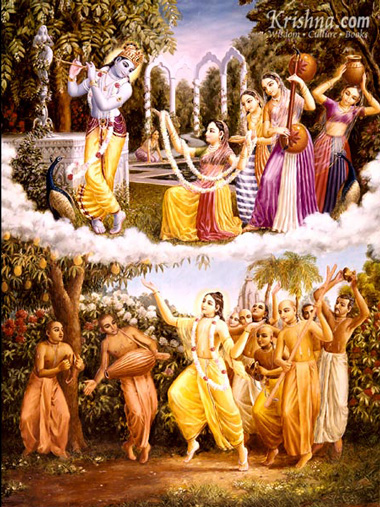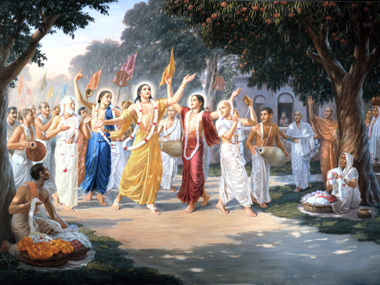 Krishna Comes as Sri Chaitanya
Krishna Comes as Sri Chaitanya
In a special appearance, Krishna personally came in A.D. 1486 as Sri Chaitanya Mahaprabhu and acted as His own devotee. Sri Chaitanya Mahaprabhu is Krishna Himself, saturated with the love for Him that Radha embodies. As the emblem of the perfect devotee of Krishna, He displayed feelings of the highest spiritual ecstasy.
Krishna taught Bhagavad-gita to liberate all souls, and He returned as Sri Chaitanya to show us how to live by the Gita’s teachings.
Because spiritual realization is difficult in the present age, Krishna as Sri Chaitanya Mahaprabhu is especially liberal. He has made pure love of God attainable by the easy process of chanting His holy names, as in the maha-mantra:
Hare Krishna, Hare Krishna, Krishna Krishna, Hare Hare
Hare Rama, Hare Rama, Rama Rama, Hare Hare.
“In this way, assuming the sentiment of a devotee, He preached devotional service while practicing it Himself.” —Chaitanya-Charitamrita, Adi 4.41.
Sri Chaitanya’s Teachings
Sri Chaitanya taught that Bhakti, or loving devotion to Krishna, is both the most effective spiritual practice and the ultimate goal of all spiritual practices.
Because He is Krishna Himself, His teachings are identical with those of Krishna in Bhagavad-gita. His only written work is His Shikshastaka, or “Eight Instructions,” a concise course in attaining spiritual perfection.
Sri Chaitanya’s disciples codified His spoken teachings to them in their books. With copious references to the Vedic scriptures, these books establish the supremacy of Bhakti. Sri Chaitanya’s teachings cover three main topics:
- knowledge of the soul’s relationship with Krishna
- the method of awakening that relationship
- the awakened state of that relationship (pure love of God)

The sankirtan movement started by Sri Chaitanya Mahaprabhu in the 1500s, chanting the maha-mantra Hare Krishna.
Sri Chaitanya also contributed immensely to theology by teaching that God is simultaneously identical to and different from His energies, including the material world and us finite souls.
Among the many books by His disciples, Krishnadasa Kaviraja’s biography Chaitanya Charitamrita is both a fascinating telling of Sri Chaitanya’s life and a rich blend of deep devotion and robust theology.
Lord Chaitanya’s incarnation is mentioned and predicted in numerous scriptures. The following are some of the important references.
In the Atharva Veda (Purusha-bodini Upanishad) it is said:
saptame gaura-varna-vishnor ity anena sva-shaktya caikyam etya prante pratar avatirya saha svaih sva-manum shikshayati
“In the seventh manvantara, the Supreme Lord will, accompanied by His own associates, descend in a golden form. He will teach the chanting of His own holy names.”

The same sankirtan movement brought to the Western world by Srila Prabhupada.
It is further stated in the Atharva Veda:
ito ‘ham krita-sannyaso ‘vatarishyami sa-guno nirvedo nishkamo bhu-girbanas tira-stho ‘lakanandayah kalau catuh-sahasrabdhopari panca-sahasrabhyantare gaura-varno dirghangah sarva-lakshana-yukta ishvara-prarthito nija-rasasvado bhakta-rupo mishrakhyo vidita-yogah syam
“The Supreme Lord Himself says: When between four thousand and five thousand years of Kali-yuga have passed, I will descend to the earth in a place by the Ganges’ shore. I will be a tall, saintly brahmana devotee of the Lord, and have a golden complexion. I will be renounced and free from all desire. I will accept the order of renunciation (sannyasa). I will be a devotee advanced in bhakti-yoga. I will chant the holy names of the Lord. I will taste the sweet mellows of My own devotional service. Only the great devotees will understand Me.”
In the eleventh canto of Srimad Bhagavatam the following verse is found:
krishna-varnam tvishakrishnam
sangopangastra-parshadam
yajnaih sankirtana-prayair
yajanti hi su-medhasah
“In the age of Kali, intelligent persons perform congregational chanting to worship the incarnation of Godhead, who constantly sings the name of Krishna. Although His complexion is not blackish, He is Krishna Himself. He is accompanied by His associates, servants, weapons, and confidential companions.”
